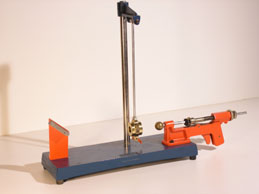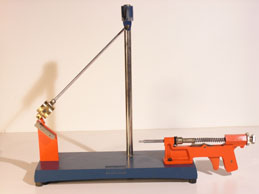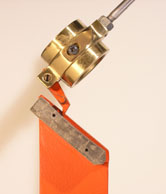The ballistic pendulum demonstrates conservation of momentum in an inelastic collision. A ball is launched from rest by a spring-loaded “gun” (Figure 1) and is caught by a bob.
After impact, the bob with the ball inside swings up to a maximum height (Figure 2). The pawl at the base of the bob catches the ratchet, which has a scale for measuring height changes (Figure 3).
Equipment:
- Ballistic pendulum setup:
- Pendulum bob
- Ratchet with scale and spring loaded “gun”
- Brass ball with hole drilled through its center
Demo:
Place the bob such that it hangs loose, perpendicular to the table top, and place the ball on the front of the spring loaded gun(see figure 1). Make sure that the spring is compressed. To compress, push on the ball in the direction away from the bob with steady force until the spring locks into place.
Now pull on the trigger of the spring loaded “gun”; the spring will eject the ball into the bob, transferring its momentum to the bob via an inelastic collision. The bob will stop at its maximum height as it catches on the ratchet, which can be measured by the scale.
Now try changing the spring constant of the “gun”, and see what happens! To loosen or tighten the spring, first loosen the larger screw and the end of the spring, then adjust the smaller screw to change the spring constant. Be sure to tighten the larger screw after adjusting in order to lock the spring into place.
Explanation:
We can define our variables as:
• m = Mass of ball
• M = Mass of bob
• u = Initial velocity of the ball (right after ejection)
• v = “Final” velocity of the ball + bob (right as the ball+bob start to move together, but before they start to rise)
Using conservation of momentum, we can equate the initial and final momentum of the ball-bob system:
We can then write the initial velocity as:
Because this is an inelastic collision, kinetic energy is not conserved, as a small amount of energy is lost to internal friction between the ball and the bob. However, we can say the total mechanical energy in the system as conserved at all times after the collision. The types of energy existing in this system are:
Kinetic Energy (KE) =
Gravitational Potential Energy (GPE) = mgh
Spring Potential Energy (SPE) =
Here, h is the height of the ball+bob system, k is the spring constant and x is the distance the spring is compressed from resting position.
Let’s look at the types of energy existing at each stage in this demo:
(1) The ball is at rest, held back by the spring.
The ball’s height is zero, so the GPE is zero. The ball is also at rest, so the KE is zero. The spring is compressed by some distance x, so some SPE exists.
GPE = 0
KE = 0
SPE =
(2) The ball is ejected, and about to hit the bob. The ball’s height is still zero, so the GPE is zero, and the spring is now at resting position, making the SPE zero. The ball now has some initial velocity, u, and kinetic energy:
GPE = 0
KE =
SPE = 0
Energy is conserved in stages (1) and (2). After the collision, some energy will be lost due to friction and sound.
(3) The ball and bob have collided inelastically and move with a new velocity, v.
GPE = 0
KE =
SPE = 0
(4) The ball and bob have risen to their maximum height, h.
GPE =
KE = 0
SPE = 0
We can now describe the velocity of the combined ball and bob after the collision by setting the KE of the system from step (3) equal to the GPE from step (4) :
Rearranging, we get:
We can then use v to calculate the initial velocity, u, using conservation of momentum:
In a frictionless system, the SPE from our initial condition (1) is equal to our KE in step (2) because total energy is always conserved. This means that if we measure the distance the spring was compressed, the initial velocity and the final height of the ball-bob system, we can calculate the spring constant:
We can also predict the maximum height the ball and bob will reach by re-writing our equation for v above as:
Using conservation of momentum, we have and plug into the previous equation:
The equation relating the spring constant and the ball velocity gives us , so we have:
In this demo, you may calculate the initial velocity, velocity after collision, spring constant, and maximum height using these measurements:
m (mass of ball) = 68g
M (mass of bob) = 200g
x (distance spring is compressed) = 5.3cm
Notes:
Use a video camera to display the scale to a large class. The spring can be difficult to compress.
Written by Lydia Seymour


